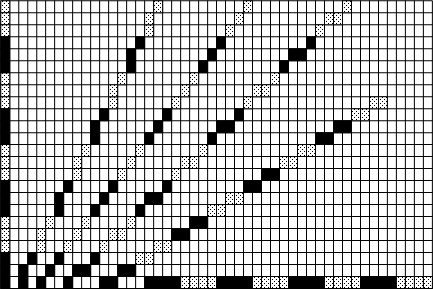Styled Cosmetic Lines
The DrvStrokePath function must support the drawing of cosmetic lines with arbitrary clipping using a solid-color brush. The driver can make a call to the GDI service PATHOBJ_vEnumStartClipLines to precompute the clipping.
Styling of a cosmetic line is similar to that of a geometric wide line because it is specified by a repeating array. For a styled cosmetic line, the array entries are LONG values that contain the lengths in style steps. The relation between style steps and pixels is defined by the xStyleStep, yStyleStep, and denStyleStep fields in the GDIINFO structure returned by the DrvEnablePDEV function.
When the driver calls PATHOBJ_bEnumClipLines, to handle styled cosmetic lines through complex clipping, GDI modifies the value of the CLIPLINE structure's iStyleState member to represent the style state. The style state is the offset back to the first pixel of the line segment; that is, the first pixel that would be rendered if the line were not clipped. The style state consists of two 16-bit values packed into a ULONG value. If HIGH and LOW are the high-order and the low-order 16 bits of the style state, a fractional version of the style state, referred to as style position, can be computed as:
style position = HIGH + LOW/denStyleStep
For example, if the values in iStyleState are 1 and 2, and denStyleStep is 3, then style position is 5/3. To determine exactly where the drawing of the style begins in the style array, take the product:
style position * denStyleStep
In this example, with a denStyleStep value of 3, the drawing position is calculated to exclude the first five (5/3 * 3) pixels of the style array. That is, drawing begins at the sixth pixel in the style array of this clipped line.
There are y-styled cosmetic lines and x-styled cosmetic lines. If a line extends dx device units in the x direction and dy units in the y direction, the line is y-styled when the following is true:
(dy * yStyleStep) >= (dx * xStyleStep)
In this case, the style position is advanced by yStyleStep/denStyleStep for each pixel advanced in the y direction.
Conversely, a line is x-styled and the style position is advanced by xStyleStep/denStyleStep for each pixel advanced in the x direction when the following is true:
(dx * xStyleStep) > (dy * yStyleStep)
When the style position advances to a new integer, the style step advances one unit in the style array.
The following figure shows several cosmetic styled lines having different slopes.

In this illustration, the pixel grid shown is not square, but is shown as it would be for an EGA display in which four pixels in the x direction represent the same distance as three pixels in the y direction. The style steps in the GDIINFO structure ensure that styled lines appear the same at any slope on displays whose pixels are not square. In this illustration, the styling array (defined by the pstyle member of the LINEATTRS structure) is {1,1}, which is a broken line having equal-sized dots and gaps. The driver's value of xStyleStep is 3, yStyleStep is 4, and denStyleStep is 12.
To illustrate further, suppose a dot matrix printer has a 144-dpi horizontal resolution and a 72-dpi vertical resolution. In addition, suppose the dot length of the minimum dot is 1/24-inch. To support this printer, select the smallest numbers for xStyleStep and yStyleStep that can compensate for the printer's aspect ratio, such as 1 for xStyleStep and 2 (144/72) for yStyleStep, and 6 (144/24) for denStyleStep.
If the LA_ALTERNATE bit is set in the flag in the LINEATTRS structure, a special style is used for a cosmetic line. In this case, every other pixel is on, regardless of direction or aspect ratio. Style state is returned as if the style array is {1,1} and xStyleStep, yStyleStep, and denStyleStep are all one. In other words, if lStyleState is zero, the first pixel is on; if lStyleState is one, the first pixel is off.
If the LA_STARTGAP bit is set in the LINEATTRS flag, the sense of the elements in the style array is inverted. The first array entry specifies the length of the first gap, the second entry specifies the length of the first dash, and so forth.
Feedback
Coming soon: Throughout 2024 we will be phasing out GitHub Issues as the feedback mechanism for content and replacing it with a new feedback system. For more information see: https://aka.ms/ContentUserFeedback.
Submit and view feedback for